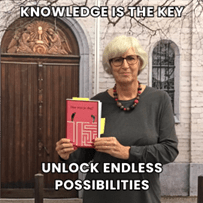Life is either a daring adventure or nothing." - Helen Keller1
Spontaneity and improvisation are fun – like on vacation, for example – when you don't have to plan anything and can just do what you feel like. But in your daily life, you still like to know what to expect and what lies ahead. Where will you go on vacation this year? And what will you do during the holidays? You love surprises, but only if they are pleasant, right?
However, uncertainty can have its advantages. Here are seven reasons why uncertainty can actually be good for you.
1. It promotes your flexibility
Uncertainty forces you to adapt to new situations. Remember that time you had to take an unexpected detour and how you quickly found a new route? Such a challenge forces you to respond quickly and efficiently in unforeseen situations. This experience teaches you that you can be flexible.
2. It stimulates your creativity
If you're not prepared for what's coming, you often can't rely on your tried-and-tested methods. You are forced to think outside the box and improvise. This can lead to more creativity. It's like cooking without a recipe, and maybe you'll discover a surprising but delicious new flavor combination that you would have never considered otherwise.
3. You learn to let go better
Uncertainty also teaches you that not everything is within your control. Think of the times when things went differently than you expected. By accepting that some things just happen, you can embrace the flow of life and let go more easily.
4. You are more in the now
An uncertain future teaches you to appreciate the present moment. This can lead to a deeper awareness of the now and a greater appreciation for the small things in life, such as appreciating an unexpected sunny day or enjoying an unplanned visit.
5. It strengthens your problem-solving ability
Uncertainty is like a mental workout. It challenges you to solve problems in new ways, thereby strengthening your thinking and adaptability. So, you become not only more creative but also more efficient in finding solutions.
6. It encourages self-discovery
When you are faced with uncertainties, you may also be confronted with yourself. You are then forced to set priorities and thus you can discover what is really important to you and what values you want to uphold.
7. It builds your resilience
Uncertainties often go hand in hand with fears. By facing these fears, you build inner strength. And this resilience helps you to face future challenges with more confidence.
In Conclusion
The uncertainties and inherent unpredictabilities of life offer you opportunities for growth, learning, and authentic living. When you face uncertainty again, remind yourself that this is an opportunity for personal development.
When has uncertainty enriched you or brought a new dimension to your life?
- Helen Keller (1880-1968) was an American author and activist. Deaf and blind from the age of 19 months, she overcame these limitations with the help of her teacher Anne Sullivan. Keller became the first deaf-blind person to earn a Bachelor of Arts degree and was an advocate for the rights of people with disabilities.
↩︎













